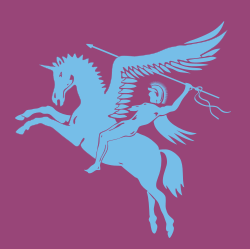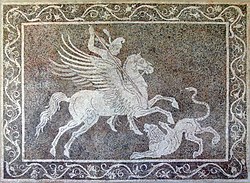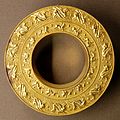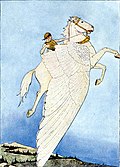Pegasus
 From Wikipedia - Reading time: 18 min
From Wikipedia - Reading time: 18 min
You can help expand this article with text translated from the corresponding article in French. (March 2018) Click [show] for important translation instructions.
|
| Pegasus | |
|---|---|
 Bellerophon riding Pegasus and slaying the Chimera, central medallion of a Gallo-Roman mosaic from Autun, Musée Rolin, 2nd to 3rd century AD. | |
| Abode | Hippocrene, Mount Helicon |
| Genealogy | |
| Parents | Poseidon and Medusa |
| Siblings | Chrysaor and several paternal half-siblings |

Pegasus (Ancient Greek: Πήγασος, romanized: Pḗgasos; Latin: Pegasus, Pegasos) is a winged horse in Greek mythology, usually depicted as a white stallion. He was sired by Poseidon, in his role as horse-god, and foaled by the Gorgon Medusa. Pegasus was the brother of Chrysaor, both born from Medusa's blood when their mother was decapitated by Perseus. Greco-Roman poets wrote about his ascent to heaven after his birth and his obeisance to Zeus, who instructed him to bring lightning and thunder from Olympus.
Pegasus is the creator of Hippocrene, the fountain on Mount Helicon. He was captured by the Greek hero Bellerophon, near the fountain Peirene, with the help of Athena and Poseidon. Pegasus allowed Bellerophon to ride him in order to defeat the monster Chimera, which led to many more exploits. Bellerophon later fell from Pegasus's back while trying to reach Mount Olympus. Both Pegasus and Bellerophon were said to have died at the hands of Zeus for trying to reach Olympus. Other tales have Zeus bring Pegasus to Olympus to carry his thunderbolts.
Long honored as a constellation, Pegasus is a subject of very rich iconography, especially through ancient Greek pottery as well as paintings and sculptures of the Renaissance.
Etymology
[edit]
The poet Hesiod presents a folk etymology of the name Pegasus as derived from πηγή pēgē 'spring, well', referring to "the pegai of Okeanos, where he was born".[1]
A proposed etymology of the name is Luwian pihassas 'lightning', and Pihassassi, a local Luwian-Hittite name in southern Cilicia of a weather deity associated with thunder and lightning. The proponents of this etymology adduce the role of Pegasus, reported as early as Hesiod, as the bringer of thunderbolts to Zeus. That interpretation was first suggested in 1952 and remains widely accepted,[2] but Robin Lane Fox (2009) has criticized it as implausible.[3]
Springs
[edit]According to early myths, everywhere the winged horse struck his hoof to the earth, an inspiring water spring burst forth. One of these springs was upon the Muses' Mount Helicon, the Hippocrene ("horse spring").[4] Antoninus Liberalis has suggested,[5] that it was opened at the behest of Poseidon to prevent the mountain from swelling with rapture at the song of the Muses. Another spring associated with Pegasus was at Troezen.[6] Hesiod relates how Pegasus was peacefully drinking from a spring when the hero Bellerophon captured him.
Thunderbolts
[edit]Hesiod wrote that Pegasus carried thunderbolts for Zeus.[7]
Birth
[edit]There are several versions of the birth of the winged stallion and his brother Chrysaor in the far distant place at the edge of Earth, Hesiod's "springs of Oceanus", which encircles the inhabited earth, where Perseus found Medusa:
One is that they sprang from the blood issuing from Medusa's neck as Perseus was beheading her,[8] similar to the manner in which Athena was born from the head of Zeus after he swallowed her pregnant mother.
In another version, when Perseus beheaded Medusa, the brothers were born of the Earth, when the Gorgon's blood fell upon her. A variation of this story holds that they were formed from the mingling of Medusa's blood, pain, and sea foam, implying that Poseidon had involvement in their making.
The last version bears resemblance to Hesiod's account of the birth of Aphrodite from the foam created when the severed genitals of Uranus were cast into the sea by Cronus.
| Sire Poseidon |
Cronus | Uranus | Gaïa or Nyx |
|---|---|---|---|
| Gaïa or Nyx | |||
| Gaïa | Chaos | ||
| Chaos | |||
| Rhea | Uranus | Gaïa or Nyx | |
| Gaïa or Nyx | |||
| Gaïa | Chaos | ||
| Chaos | |||
| Dam Medusa |
Phorcys | Pontus | Ether or Uranus |
| Gaïa | |||
| Gaïa | Chaos | ||
| Chaos | |||
| Ceto | Pontus | Ether or Uranus | |
| Gaïa | |||
| Gaïa | Chaos | ||
| Chaos |
Bellerophon
[edit]
Pegasus aided the hero Bellerophon in his fight against the Chimera. There are varying tales about how Bellerophon found Pegasus; the most common[9] being that the hero was told by Polyeidos to sleep in the temple of Athena, where the goddess visited him in the night and presented him with a golden bridle. The next morning, still clutching the bridle, Bellerophon found Pegasus drinking at the Pierian spring, caught him, and eventually tamed him.
Perseus
[edit]Michaud's Biographie universelle relates that when Pegasus was born, he flew to where thunder and lightning are released. Then, according to certain versions of the myth, Athena tamed him and gave him to Perseus, who flew to Ethiopia to help Andromeda.[10]
Olympus
[edit]
After Bellerophon fell off Pegasus while trying to reach Olympus, Pegasus and Athena left him and continued to Olympus where he was stabled with other steeds belonging to Zeus, and was given the task of carrying Zeus' thunderbolts, along with other members of his entourage, his attendants/handmaidens/shield bearers/shieldmaidens, Astrape and Bronte.
Because of his years of faithful service to Zeus, Pegasus was later honoured with transformation into a constellation.[11] On the day of his catasterism, when Zeus transformed him into a constellation, a single feather fell to Earth near the city of Tarsus.[12]
Legacy
[edit]In heraldry
[edit]The pegasus became a common element in British heraldry, appearing chiefly as a supporter or a crest. Pegasi may also appear upon escutcheons, although this is rare. A pegasus rampant is featured on the arms of the Inner Temple, while those of the Richardson family contain a rare depiction of a pegasus sejant.[13]
World War II emblem
[edit]During World War II, the silhouetted image of Bellerophon the warrior, mounted on the winged Pegasus, was adopted by the United Kingdom's newly raised parachute troops in 1941 as their upper sleeve insignia.

The image clearly symbolized a warrior arriving at a battle by air, the same tactics used by paratroopers. The square upper-sleeve insignia comprised Bellerophon/Pegasus in light blue on a maroon background. One source suggests that the insignia was designed by famous English novelist Daphne du Maurier, who was wife of the commander of the 1st Airborne Division (and later the expanded British Airborne Forces), General Frederick "Boy" Browning. According to the British Army Website, the insignia was designed by the celebrated East Anglian painter Major Edward Seago in May 1942. The maroon background on the insignia was later used again by the Airborne Forces when they adopted the famous maroon beret in Summer 1942. The beret was the origin of the German nickname for British airborne troops, the Red Devils. Today's Parachute Regiment carries on the maroon beret tradition. The selection process for the elite Parachute Regiment is called Pegasus Company (often abbreviated to "P Company").
In 2015 it was announced that the units of 16 Air Assault Brigade would once again use the Pegasus insignia after a 15-year hiatus.[14]
During the airborne phase of the Normandy invasion on the night of 5–6 June 1944, British 6th Airborne Division captured all its key objectives in advance of the seaborne assault, including the capture and holding at all costs of a vital bridge over the Caen Canal, near Ouistreham. In memory of their tenacity, the bridge has been known ever since as Pegasus Bridge.
The Tuscan National Liberation Committee during the German occupation of Italy also had a Pegasus as its emblem. The winged horse is still featured on the Tuscan flag and coat of arms.

In popular culture
[edit]The winged horse has provided an instantly recognizable corporate logo or emblem of inspiration. Ecuador launched its weather satellite, named Pegaso (pronounced [peˈɣaso], Pegasus in Spanish), on 26 April 2013 but it was damaged by Russian space debris.[15] Pegasus Airlines (Turkish: Pegasus Hava Taşımacılığı A.Ş.) is a low-cost airline headquartered in the Kurtköy area of Pendik, Istanbul, Turkey. Mobil Oil has had a Pegasus as its company logo since its affiliation with Magnolia Petroleum Company in the 1930s. TriStar Pictures famously uses a winged horse in their logo.
Gallery
[edit]-
Bellerophon, Pegasus, and Athena, fresco of the 3rd style from Pompeii, first half of the 1st century
-
Bronze figurine (Greece, sixth century BC)
-
Bellerophon mounted on Pegasus fighting the Chimera, side A from an Attic red-figure pelike
-
Bellerophon and the Chimera, edge of an Attic red-figure epinetron (thigh-protector used by a woman when weaving)
-
Reel (probably an ear-stud) with representations of Pegasus and Chimaira
-
Pegasus, Attic red-figure squat lekythos, 480–460 BC, from Sicily
-
Parthian era bronze plate depicting Pegasus (Pegaz in Persian), excavated in Masjed Soleyman, Khūzestān, Iran
-
A 1914 illustration depicting Bellerophon riding Pegasus
See also
[edit]References
[edit]- ^ Noted by Karl Kerényi, The Heroes of the Greeks, 1959:80: "In the name Pegasos itself the connection with a spring, pege, is expressed."
- ^ The connection of Pegasus with Pihassas was suggested by H.T. Bossert, "Die phönikisch-hethitischen Bilinguen vom Karatepe", Jahrbuch für kleinasiatische Forschung, 2 1952/53:333, P. Frei, "Die Bellerophontessaga und das Alte Testament", in B. Janowski, K. Koch and G. Wilhelm, eds., Religionsgeschichtliche Beziehungen zwischen Kleinasien, Nordsyrien und der Alte Testament, 1993:48f, and Hutter, "Der luwische Wettergott pihašsašsi under der griechischen Pegasos", in Chr. Zinko, ed. Studia Onomastica et Indogermanica... 1995:79–98. Commentary was provided by R. S. P. Beekes in his Etymological Dictionary of Greek, Brill, 2009, p. 1183.
- ^ "a storm god is not the origin of a horse. However, he had a like-sounding name, and Greek visitors to Cilicia may have connected their existing Pegasus with Zeus's lightning after hearing about this 'Pihassassi' and his functions and assuming, wrongly, he was their own Pegasus in a foreign land." Robin Lane Fox, Travelling Heroes in the Epic Age of Homer, Knopf Doubleday Publishing Group, 2009, ISBN 9780307271518, pp. 207ff.
- ^ Pausanias, 9. 31. 3.
- ^ Antoninus Liberalis, Metamorphoses 9
- ^ Pausanias, 2. 31. 9.
- ^ "Hesiod, Theogony, line 270".
- ^ Hesiod, Theogony 281; Pseudo-Apollodorus, Bibliotheke 2. 42, et al. Harris, Stephen L. and Gloria Platzner. Classical Mythology: Images and Insights. 2nd ed. (New York: Mayfield Publishing), 1998. 234.
- ^ For example in Pindar, Olympian Ode 13.
- ^ Michaud, Joseph F. & Michaud, Louis G. (1833). Michaud Frères (ed.). Biographie universelle, ancienne et moderne, ou Histoire, par ordre alphabétique, de la vie publique et privée de tous les hommes qui se sont fait remarquer par leurs écrits, leurs actions, leurs talents, leurs vertus ou leurs crimes (in French). Vol. 5. Retrieved 23 June 2009.
- ^ Aratus, Phaenomena 206; Scott Littleton, Mythology. The Illustrated Anthology of World Myth and Storytelling London: Duncan Baird, 2002:147. ISBN 1-903296-37-4
- ^ Grimal, Pierre (4 September 1996). Trans. by A. R. Maxwell-Hyslop (ed.). The Dictionary of Classical Mythology. Oxford: Blackwell Publishing. p. 349. ISBN 978-0-631-20102-1.
- ^ Arthur Charles Fox-Davies. A Complete Guide to Heraldry, T.C. and E.C. Jack, London, 1909, 202, https://archive.org/details/completeguidetoh00foxduoft.
- ^ Farmer, Ben (22 October 2015). "Paras win 15-year battle to reinstate Pegasus emblem". The Daily Telegraph. London. Archived from the original on 11 January 2022. Retrieved 21 March 2018.
- ^ "Ecuador Pegasus satellite fears over space debris crash – BBC News". BBC News. 24 May 2013.
External links
[edit]- The Warburg Institute Iconographic Database (images of Pegasus)
 Media related to Pegasus at Wikimedia Commons
Media related to Pegasus at Wikimedia Commons- Chisholm, Hugh, ed. (1911). . Encyclopædia Britannica (11th ed.). Cambridge University Press.
 KSF
KSF









